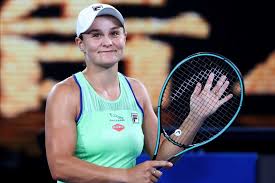For a nation that has been sifting through the dirt for decades for a truly loveable tennis champion, Australia has finally hit the mother lode in Ash Barty.
The Queenslander is that rarest of rare gems in sport: a relentless winner who is also universally adored and respected.
It’s not something Australia has had in abundance of late, in tennis or in any sport for that matter.
Still only 23, Barty is not yet even at her peak. Barring injury or a dramatic loss of form, she’ll spend much of the next decade at or near the top of the sport, and that represents a remarkable opportunity to grow the game in this country.
How Tennis Australia must have fantasised about having someone like Barty as they toiled away during the Bernard Tomic years.
Australian great Todd Woodbridge, who was the head of professional tennis with Tennis Australia for much of the last decade, believes Barty has already opened new doors for the game.
“What she’s done for our sport is she’s put it into people’s homes who probably wouldn’t think about playing tennis,” said Woodbridge.
“I feel like Australia was longing for someone like her.
“We’ve had our woes in tennis behaviour, our woes in cricket, our woes in swimming, football codes, but she’s a throwback to an era that Australia loved.
“I just think she’s been the best thing that’s possibly happened in sport.”
In the past 12 months, with a maiden grand slam title under her belt and a rise to number one in the WTA rankings, Barty has gone from promising prospect to national hero, and yet, walking around Melbourne Park, it’s not uncommon to hear people expressing their surprise that Barty is the tournament’s top seed.
‘I was told I was too short to play’
That most people know she’s good, but not everyone knows she’s the best is probably a symptom of Australia’s hit and miss relationship with tennis.
If it’s Barty holding the Daphne Akhurst Memorial Cup aloft on Saturday, that relationship will surely take a turn for the better.
What’s already clear is that Barty wants to use her rising profile to be an agent of change and there are some obvious areas — namely female sport and Indigenous sport — where she can make a real difference.
Barty is the face of Tennis Australia’s Play For You campaign, which is designed to encourage girls to stay in sport for longer. The campaign is trying to arrest a trend that sees 36 per cent of girls quit sport by the time they reach 18.
“I was told I was too short to play”, Barty says in the campaign video, which has been playing during her matches at Rod Laver Arena.
That the woman herself comes onto court moments later and sends down a 185kph ace gives the ad extra oomph.
Ash Barty is the perfect person to address an imbalance in tennis that means its participants are mostly men.
According to the most recent Sport Australia research, men make up 57 per cent of tennis players in this country. Of the women who do play, those aged over 65 account for the biggest participation group.
‘She’s fun, she’s Australian and she wins a lot’
Recently retired Australian star Jelena Dokic believes Barty will make a significant difference on that front.
“I think she’s been incredible. Such an inspiration, so many people looking up to her but especially young kids and young girls,” said Dokic.
“To have someone who’s obviously such an incredible athlete and tennis player, number one in the world and a grand slam champion, but also to be so humble and down to earth I think we’re really lucky to have her.
“We haven’t had someone that successful that’s such an inspiration in a very long time so that’s great to see.”
Nine-year-old Gemma Pearson and her family are among the more than 50 thousand people a day coming to Melbourne Park for the Australian Open. Nearly all of them will pass the wall just outside Rod Laver Area which is plastered with action shots of today’s biggest stars, including Barty.
In just a few words, Gemma sums up why girls of her age are attracted to the Queenslander.
“She’s fun, she’s Australian and she wins a lot.”
It’s as simple as that.
In a country where the occasional misadventures of male tennis players have drawn too much attention, Gemma’s father, Lee Pearson, is delighted that his daughter has someone like Barty to be inspired by.
“I don’t know if it’s just that she’s more relatable, that she’s Australian, but Gemma really looks up to her,” said Lee.
“She’s humble, her effort is amazing and she always talks about her team.”
Helen Von Roehl is lining up to take a selfie in front of Ash’s larger-than-life-sized picture outside Rod Laver Arena. Helen is an Indigenous woman from the Northern Territory. She’s been waiting a long time for someone like Barty to come along.
“Being Indigenous we really want her to win and she’s going to win this year,” said Helen.
“I haven’t really been able to cheer on any other Indigenous players because we don’t get enough here.
“She’s really cool, calm and collected, she doesn’t rush for anybody and I just love that.”
According to the Australian Sports Commission, the participation rate of Indigenous women in sport is lower than any other group. Lower even than people with a disability.
There are issues at play there that may be beyond Barty’s sphere of influence, but her visibility can only be positive.
“I’m an extremely proud Indigenous woman,” the world number one said after her Australia Day win over Alison Riske.
They were words rarely heard in tennis circles since the days of Evonne Goolagong 40 years ago, and welcome words indeed.

